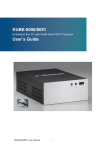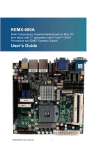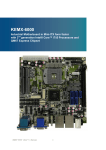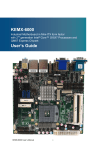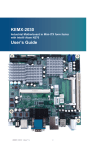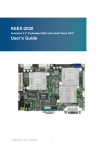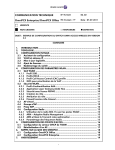Download Quanmax KUBE-8040 User`s guide
Transcript
KUBE-8040 Embedded Box PC with Intel® Core 2 Duo Processor User’s Guide KUBE-8040 User’s Manual I Contact Info: Quanmax Inc. 5F, No. 415, Ti-Ding Blvd. Sec. 2, NeiHu District, Taipei, Taiwan 114 Tel: +886-2-2799-2789 Fax: +886-2-2799-7399 Visit our site at: www.quanmax.com © 2009 Quanmax Inc. All rights reserved. The information in this user’s guide is provided for reference only. Quanmax does not assume any liability arising out of the application or use of the information or products described herein. This user’s guide may contain or reference information and products protected by copyrights or patents and does not convey any license under the patent rights of Quanmax, nor the rights of others. Quanmax is a registered trademark of Quanmax. All trademarks, registered trademarks, and trade names used in this user’s guide are the property of their respective owners. All rights reserved. This user’s guide contains information proprietary to Quanmax. Customers may reprint and use this user’s guide in other publications. Customers may alter this user’s guide and publish it only after they remove the Quanmax name, cover, and logo. Quanmax reserves the right to make changes without notice in product or component design as warranted by evolution in user needs or progress in engineering or manufacturing technology. Changes which affect the operation of the unit will be documented in the next revision of this user’s guide. Revision Date Edited by Changes 1.0 2010/07/02 Zack Initial Release KUBE-8040 User’s Manual II Content Content....................................................................................................................... 3 Figures ....................................................................................................................... 5 Tables ......................................................................................................................... 6 Safety Instructions ...................................................................................................... 7 Before You Begin .................................................................................. 7 When Working Inside a Computer ........................................................ 7 Preventing Electrostatic Discharge ....................................................... 8 Instructions for Lithium Battery ............................................................. 9 Preface ..................................................................................................................... 10 How to Use This Guide ....................................................................... 10 Unpacking ........................................................................................... 10 Regulatory Compliance Statements .................................................... 10 Warranty Policy ................................................................................... 11 Maintaining Your Computer ................................................................. 12 Chapter 1 Introduction ........................................................................................... 15 Overview ............................................................................................. 15 Product Specifications ........................................................................ 16 Front view of the computer ................................................................. 17 Rear view of the computer .................................................................. 17 Mechanical Layout .............................................................................. 18 Chapter 2 Assembly/Disassembly ......................................................................... 19 Accessing Internal Components ......................................................... 19 Memory Module Installation ................................................................ 21 Chapter 3 Getting Started ...................................................................................... 22 Power Connection .............................................................................. 22 Operating System and Drivers ............................................................ 22 Jumper Settings .................................................................................. 23 Maintenance and Prevention .............................................................. 25 Chapter 4 AMI BIOS Setup .................................................................................... 26 Overview ............................................................................................. 26 Main Menu .......................................................................................... 27 Advanced Menu .................................................................................. 29 Boot Menu .......................................................................................... 33 Chipset Menu ...................................................................................... 34 KUBE-8040 User’s Manual 3 Power Menu ........................................................................................ 35 Security Menu ..................................................................................... 36 Exit Menu ............................................................................................ 37 Appendix A DIO (Digital I/O) Sample Code .............................................................. 39 Appendix B WatchDog Timer Sample Code ............................................................ 41 KUBE-8040 User’s Manual 4 Figures Figure 1 Mechanical Dimensions………………………………………….…18 Figure 2 Remove Top Chassis Cover………………………….……………19 Figure 3 Install mini-PCIe Module……… ………………….………….…….20 Figure 4 Remove Bottom Chassis Cover…………..…………………….…20 Figure 5 Align the SO-DIMM Module……………..………………………… 21 Figure 6 Press Down on the SO-DIMM Module…….…………..……..…...21 Figure 7 Jumper Location……………………….…….…………..……..…...24 KUBE-8040 User’s Manual 5 Tables Table 1 KUBE-8040 product specifications ................................................ 16 Table 2 Jumper List .................................................................................... 23 Table 3 JP1, Clear CMOS Selection .......................................................... 23 Table 4 JP2, 7, 13, 14 and COM Port Signal/Power Selection ................... 23 Table 5 JP15, Mini PCIE Revision Selection .............................................. 24 Table 6 BIOS Main Menu ........................................................................... 27 Table 7 SATA and OnBoard CF Device Setting Menu ................................ 28 Table 8 System Information........................................................................ 29 Table 9 Advanced Menu ............................................................................. 29 Table 10 I/O Configuration ......................................................................... 30 Table 11 Onboard Peripherals Configuration Settings ............................... 31 Table 12 Hardware Health Configuration ................................................... 32 Table 13 Boot Menu ................................................................................... 33 Table 14 Chipset Menu .............................................................................. 34 Table 15 Video Function Configuration ...................................................... 34 Table 16 Power Menu ................................................................................ 35 Table 17 Security Menu ............................................................................. 36 Table 18 Exit Menu .................................................................................... 37 KUBE-8040 User’s Manual 6 Safety Instructions Before You Begin Before handling the product, read the instructions and safety guidelines on the following pages to prevent damage to the product and to ensure your own personal safety. Refer to the “Advisories” section in the Preface for advisory conventions used in this user’s guide, including the distinction between Warnings, Cautions, Important Notes, and Notes. Always use caution when handling/operating a computer. Only qualified, experienced, authorized electronics service personnel should access the interior of a computer. The power supplies produce high voltages and energy hazards, which can cause bodily harm. Use extreme caution when installing or removing components. Refer to the installation instructions in this user’s guide for precautions and procedures. If you have any questions, please contact Quanmax Post-Sales Technical Support. Access can only be gained by service persons or by users who have been instructed about the reasons for the restrictions applied to the location and about any precautions that shall be taken; and access is through the use of a tool or lock and key, or other means of security, and is controlled by authority responsible for the location. WARNING High voltages are present inside the chassis when the unit’s power cord is plugged into an electrical outlet. Turn off system power, turn off the power supply, and then disconnect the power cord from its source before removing the chassis cover. Turning off the system power switch does not remove power to components. When Working Inside a Computer Before taking covers off a computer, perform the following steps: 1. Turn off the computer and any peripherals. 2. Disconnect the computer and peripherals from their power sources or subsystems to prevent electric shock or system board damage. This does not KUBE-8040 User’s Manual 7 3. 4. apply when hot swapping parts. Follow the guidelines provided in “Preventing Electrostatic Discharge” on the following page. Disconnect any telephone or telecommunications lines from the computer. In addition, take note of these safety guidelines when appropriate: To help avoid possible damage to system boards, wait five seconds after turning off the computer before removing a component, removing a system board, or disconnecting a peripheral device from the computer. When you disconnect a cable, pull on its connector or on its strain-relief loop, not on the cable itself. Some cables have a connector with locking tabs. If you are disconnecting this type of cable, press in on the locking tabs before disconnecting the cable. As you pull connectors apart, keep them evenly aligned to avoid bending any connector pins. Also, before connecting a cable, make sure both connectors are correctly oriented and aligned. CAUTION Do not attempt to service the system yourself except as explained in this user’s guide. Follow installation and troubleshooting instructions closely. Preventing Electrostatic Discharge Static electricity can harm system boards. Perform service at an ESD workstation and follow proper ESD procedure to reduce the risk of damage to components. Quanmax strongly encourages you to follow proper ESD procedure, which can include wrist straps and smocks, when servicing equipment. You can also take the following steps to prevent damage from electrostatic discharge (ESD): When unpacking a static-sensitive component from its shipping carton, do not remove the component’s antistatic packing material until you are ready to install the component in a computer. Just before unwrapping the antistatic packaging, be sure you are at an ESD workstation or grounded. This will discharge any static electricity that may have built up in your body. When transporting a sensitive component, first place it in an antistatic container or packaging. Handle all sensitive components at an ESD workstation. If possible, use antistatic floor pads and workbench pads. KUBE-8040 User’s Manual 8 Handle components and boards with care. Don’t touch the components or contacts on a board. Hold a board by its edges or by its metal mounting bracket. Do not handle or store system boards near strong electrostatic, electromagnetic, magnetic, or radioactive fields. Instructions for Lithium Battery WARNING Danger of explosion when battery is replaced with incorrect type. Only replace with the same or equivalent type recommended by the manufacturer. Do not dispose of lithium batteries in domestic waste. Dispose of the battery according to the local regulations dealing with the disposal of these special materials (e.g. to the collecting points for disposal of batteries KUBE-8040 User’s Manual 9 Preface How to Use This Guide This guide is designed to be used as step-by-step instructions for installation, and as a reference for operation, troubleshooting, and upgrades. NOTE Driver downloads and additional information are available under Downloads on our web site: www.quanmax.com. Unpacking When unpacking, follow these steps: 1. After opening the box, save it and the packing material for possible future shipment. 2. Remove all items from the box. If any items listed on the purchase order are missing, notify Quanmax customer service immediately. 3. Inspect the product for damage. If there is damage, notify Quanmax customer service immediately. Refer to “Warranty Policy” for the return procedure. Regulatory Compliance Statements This section provides the FCC compliance statement for Class A devices. FCC Compliance Statement for Class A Devices The product(s) described in this user’s guide has been tested and found to comply with the limits for a Class A digital device, pursuant to Part 15 of the FCC Rules. These limits are designed to provide reasonable protection against harmful interference when the equipment is operated in a commercial environment. This equipment generates, uses, and can radiate radio frequency energy and, if not installed and used in accordance with the user’s guide, may cause harmful interference to radio communications. Operation of this equipment in a residential KUBE-8040 User’s Manual 10 area (domestic environment) is likely to cause harmful interference, in which case the user will be required to correct the interference (take adequate measures) at their own expense. Changes or modifications not expressly approved by Quanmax could void the user's authority to operate the equipment. NOTE The assembler of a personal computer system may be required to test the system and/or make necessary modifications if a system is found to cause harmful interference or to be noncompliant with the appropriate standards for its intended use. Warranty Policy Limited Warranty Quanmax Inc.’s detailed Limited Warranty policy can be found under Support at www.quanmax.com. Please consult your distributor for warranty verification. The limited warranty is void if the product has been subjected to alteration, neglect, misuse, or abuse; if any repairs have been attempted by anyone other than Quanmax or its authorized agent; or if the failure is caused by accident, acts of God, or other causes beyond the control of Quanmax or the manufacturer. Neglect, misuse, and abuse shall include any installation, operation, or maintenance of the product other than in accordance with the user’s guide. No agent, dealer, distributor, service company, or other party is authorized to change, modify, or extend the terms of this Limited Warranty in any manner whatsoever. Quanmax reserves the right to make changes or improvements in any product without incurring any obligation to similarly alter products previously purchased. Return Procedure For any Limited Warranty return, please contact Support at www.quanmax.com and login to obtain a Return Material Authorization (RMA) Number. If you do not have an account, send an email to [email protected] to apply for one. All product(s) returned to Quanmax for service or credit must be accompanied by a Return Material Authorization (RMA) Number. Freight on all returned items must be prepaid by the customer who is responsible for any loss or damage caused by common carrier in transit. Returns for Warranty must include a Failure Report for KUBE-8040 User’s Manual 11 each unit, by serial number(s), as well as a copy of the original invoice showing the date of purchase. To reduce risk of damage, returns of product must be in a Quanmax shipping container. If the original container has been lost or damaged, new shipping containers may be obtained from Quanmax Customer Service at a nominal cost. Quanmax owns all parts removed from repaired products. Quanmax uses new and reconditioned parts made by various manufacturers in performing warranty repairs and building replacement products. If Quanmax repairs or replaces a product, its warranty term is not extended. Shipments not in compliance with this Limited Warranty Return Policy will not be accepted by Quanmax. Limitation of Liability In no event shall Quanmax be liable for any defect in hardware, software, loss, or inadequacy of data of any kind, or for any direct, indirect, incidental, or consequential damages in connection with or arising out of the performance or use of any product furnished hereunder. Quanmax’s liability shall in no event exceed the purchase price of the product purchased hereunder. The foregoing limitation of liability shall be equally applicable to any service provided by Quanmax or its authorized agent. Maintaining Your Computer Cleaning Components Your KUBE-8040 requires minimal maintenance and care to keep it operating correctly. Occasionally wipe the system with a soft dry cloth. You should only remove persistent dirt by use of a soft, slightly damp cloth (use only a mild detergent). Make sure the ventilation holes are clear of debris. CAUTION Do NOT do any of the following: Allow water to enter the computer Use a heavily dampened cloth Spray water directly inside of computer KUBE-8040 User’s Manual 12 Environmental Factors Temperature The ambient temperature within an enclosure may be greater than room ambient temperature. Installation in an enclosure should be such that the amount of air flow required for safe operation is not compromised. Consideration should be given to the maximum rated ambient temperature. Overheating can cause a variety of problems, including premature aging and failure of chips or mechanical failure of devices. If the system has been exposed to abnormally cold temperatures, allow a two-hour warm-up period to bring it up to normal operating temperature before turning it on. Failure to do so may cause damage to internal components, particularly the hard disk drive. Humidity High-humidity can cause moisture to enter and accumulate in the system. This moisture can cause corrosion of internal components and degrade such properties as electrical resistance and thermal conductivity. Extreme moisture buildup inside the system can result in electrical shorts, which can cause serious damage to the system. Buildings in which climate is controlled usually maintain an acceptable level of humidity for system equipment. However, if a system is located in an unusually humid location, a dehumidifier can be used to maintain the humidity within an acceptable range. Refer to the “Specifications” section of this user’s guide for the operating and storage humidity specifications. Altitude Operating a system at a high altitude (low pressure) reduces the efficiency of the cooling fans to cool the system. This can cause electrical problems related to arcing and corona effects. This condition can also cause sealed components with internal pressure, such as electrolytic capacitors, to fail or perform at reduced efficiency. Power Protection The greatest threats to a system’s supply of power are power loss, power spikes, and power surges caused by electrical storms, which interrupt system operation and/or damage system components. To protect your system, always properly ground power cables and one of the following devices. KUBE-8040 User’s Manual 13 Surge Protector Surge protectors are available in a variety of types and usually provide a level of protection proportional with the cost of the device. Surge protectors prevent voltage spikes from entering a system through the AC power cord. Surge protectors, however, do not offer protection against brownouts, which occur when the voltage drops more than 20 percent below the normal AC line voltage level. Line Conditioner Line conditioners go beyond the overvoltage protection of surge protectors. Line conditioners keep a system’s AC power source voltage at a fairly constant level and, therefore, can handle brownouts. Because of this added protection, line conditioners cost more than surge protectors. However, line conditioners cannot protect against a complete loss of power. Uninterruptible Power Supply Uninterruptible power supply (UPS) systems offer the most complete protection against variations on power because they use battery power to keep the server running when AC power is lost. The battery is charged by the AC power while it is available, so when AC power is lost, the battery can provide power to the system for a limited amount of time, depending on the UPS system. UPS systems range in price from a few hundred dollars to several thousand dollars, with the more expensive unit s allowing you to run larger systems for a longer period of time when AC power is lost. UPS systems that provide only 5 minutes of battery power let you conduct an orderly shutdown of the system, but are not intended to provide continued operation. Surge protectors should be used with all UPS systems, and the UPS system should be Underwriters Laboratories (UL) safety approved. CAUTION RISK OF EXPLOSION IF BATTERY IS REPLACED BY AN INCORRECT TYPE. DISPOSE OF USED BATTERIES ACCORDING TO THE INSTRUCTIONS KUBE-8040 User’s Manual 14 Chapter 1 Introduction Overview The KUBE-8040 is a compact Box PC ideal for space-critical applications. This powerful embedded hardware platform is designed with Intel® Core 2 Duo Processor which provides with excellent performance enabled by 45nm Process Technology. The system is supported with Intel® GM45 / ICH9-M chipset, and 2 x DDR3 800/1066 SO-DIMM up to 8GB. Featured are a 2.5” SATA HDD, Mini PCIe slot, CF, dual Gigabit Ethernet, 6 x USB 2.0, VGA, HDMI, DVI-D, 4 x DIO and 5 x COM. The KUBE-8040 provides high performance, reliability for harsh environments, compact size, noiseless operation and is highly suited to a wide range of industrial applications such as Kiosk, ATM, Gaming, Transportation, Entertainment, Surveillance, and Thin Servers. Wall and desktop mounting supported. Checklist KUBE-8040 Options Driver CD * 1 Wireless Antenna * 2 Quick Installation Guide * 1 Wall-Mount Bracket * 2 Screws for Wall-Mount Bracket* 1 (1 pack) Features Intel® Core 2 Duo processor support Intel® GM45 + ICH9-M chipset, 2x DDR3 800/1066 SO-DIMM Socket, up to 8GB 2x GbE, 1x 2.5” HDD, 5 x COMs, VGA, 6 x USB, HDMI, DVI-D, 4 x DIOs Optional WiFi antenna Heavy-duty steel chassis with fanless design KUBE-8040 User’s Manual 15 Product Specifications Construction Heavy-duty steel chassis System Board Mini-ITX Embedded SBC, Intel® Core 2 Duo, Intel® GM45 + ICH9-M Memory 2 x DDR3 800/1066 SO-DIMM Socket, up to 8GB Front I/O Power Switch Power LED HDD Activity LED 2 USB Ports Rear I/O 2x RJ-45, GbE I/O Panel 4x USB 2.0 1x VGA, DB-15 connector 1x DVI-D 5x COM 4 x DIOs 1x HDMI Mic-in, Line-in, Line-out (HD audio) 2x Antenna Connector (optional) Drive Bays Power Adapter Cooling Expansion Slot 1x 2.5" Hard Drive Bay (SATA) Input: 100-240 VAC, 50-60 Hz Output: +12VDC/6.66A output 80 Watts Fanless 1 x Mini PCI-Express Socket (for optional WiFi) 1 x CF Socket (Internal) Temperature/ Operating: 0°C to 40°C(HDD), 0°C to 50°C(SSD) Humidity Storage: -20°C to 80°C, 0%-90%, non-condensing Dimensions 230 x 86 x 212 mm (WxHxD) Weight 5.6 kg (Include Accessories and Paper Box) Mounting Desktop, Wall-mount Certification CE, FCC Class A Table 1 KUBE-8040 product specifications KUBE-8040 User’s Manual 16 Front view of the computer Rear view of the computer KUBE-8040 User’s Manual 17 Mechanical Layout Figure 1 Mechanical Dimensions KUBE-8040 User’s Manual 18 Chapter 2 Assembly/Disassembly Accessing Internal Components WARNING Before opening your system, make sure to turn it off and disconnect the power sources to prevent electric shock or system damage. Follow the procedure described below to access the system's internal components (Top Cover) 1. Loosen the 6 flathead screws from right and left side of the computer. 2. Remove the chassis top cover off the chassis base. Figure 2 Remove Top Chassis Cover KUBE-8040 User’s Manual 19 3. 4. Place your mini-PCIe module toward the mini-PCIe socket. Tightening the screw on the hole of the mini-PCIe module as shown below. Figure 3 Install mini-PCIe Module (Bottom Cover) 1. Loosen the 6 flathead screws from right and left side of the computer. 2. Remove the chassis bottom cover off the chassis base. 3. Then you could Install/Remove the HDD and CF as shown below. Figure 4 Remove Bottom Chassis Cover KUBE-8040 User’s Manual 20 Memory Module Installation Carefully follow the steps below in order to install the SO-DIMMs: 1. 2. 3. To avoid generating static electricity and damaging the SO-DIMM, ground yourself by touching a grounded metal surface or use a ground strap before you touch the SO-DIMM. Do not touch the connectors of the SO-DIMM. Dirt or other residue may cause a malfunction. Hold the SO-DIMM with its notch aligned with the memory socket of the board and insert it at a 30-degree angle into the socket. Figure 5 Align the SO-DIMM Memory Module with the onboard socket 4. 5. Fully insert the module into the socket until a “click” is heard. Press down on the SO-DIMM so that the tabs of the socket lock on both sides of the module Figure 6 Press down on the SO-DIMM Memory Module Removing a SO-DIMM: To remove the SO-DIMM, use your fingers or a small screwdriver to carefully push away the tabs that secure either side of the SO-DIMM. Lift it out of the socket. NOTE Make sure you store the SO-DIMM in an anti-static bag. The socket must be populated with memory modules of the same size and manufacturer. KUBE-8040 User’s Manual 21 Chapter 3 Getting Started Power Connection CAUTION Use the power cord suitable for the power supply in your country. Do not remove or alter the grounding prong on the power cord. In situations where a two-slot receptacle is present, have it replaced with a properly grounded three-prong grounding type receptacle. Operating System and Drivers If your product does not come with an operating system pre-installed, you will need to install an operating system and the necessary drivers to operate it. After you have finished assembling your system and connected the appropriate power source, power it up using the power switch and install the desired operating system. You can download the drivers for the product from the Quanmax website at www.quanmax.com and install as instructed there. For other operating systems, please contact Quanmax. NOTE When the system reboots without connecting the CRT, there might be no image on screen when you insert the CRT/VGA cable. Please pressing <Ctrl>+<Alt>+<F1> simultaneously to show the image on screen. KUBE-8040 User’s Manual 22 Jumper Settings To ensure correct system configuration, the following section describes how to set the jumpers to enable/disable or change functions. For jumper descriptions, please refer to the table below. Table 2 Jumper List Label Function JP1 Clear CMOS Selection JP13 COM1 Signal / Power Selection JP14 COM2 Signal / Power Selection JP7 COM3 Signal / Power Selection JP2 COM4 Signal / Power Selection JP15 MPCIE Rev select Table 3 JP1, Clear CMOS Selection Jumper Status Open Normal Operation (default) Short Clear CMOS Pitch: 2.54mm [YIMTEX 3321*02SAGR(6T)] Table 4 JP13, JP14, JP7, JP2, COM1, 2, 3, 4 Port Signal / Power Selection Jumper 1 Setting Function 1-3 Short Pin 1 = +12V 3-5 Short Pin 1 = +5V 5-7 Short Pin 1 = +5V 7-9 Short 2 Pin 1 = DCD@RS232, TX-@RS422, DATA-@RS485(Half Duplex) (default) 2-4 Short Pin 9 = +12V 4-6 Short Pin 9 = +5V 6-8 Short Pin 9 = +5V 8-10 Short Pin 9 = RI (default) JP2,JP7,JP13,JP14 : Pitch:2.54mm [YIMTEX 3322*05SAGR(6T] LEAD FREE KUBE-8040 User’s Manual 23 Table 5 JP15, Mini PCIE Revision Selection Jumper Status 1-2 MPCIE Rev1.1 (default) 2-3 MPCIE Rev1.2 PIN HEADER,DIP 3P 1R MALE STRAIGHT TYPE Pitch:2.54mm [YIMTEX 3321*03SAGR(6T)] LEAD FREE Figure 7 Jumper Location KUBE-8040 User’s Manual 24 Maintenance and Prevention Your system requires minimal maintenance and care to keep it operating correctly. Occasionally wipe the system with a soft dry cloth. You should only remove persistent dirt by use of a soft, slightly damp cloth (use only a mild detergent). Make sure the ventilation holes are clear of debris. CAUTION Do NOT do any of the following: Allow water to enter the computer Use a heavily dampened cloth Spray water directly inside of computer -------------------------------------------------------------------------------------------------------------- KUBE-8040 User’s Manual 25 Chapter 4 AMI BIOS Setup Overview This chapter provides a description of the AMI BIOS. The BIOS setup menus and available selections may vary from those of your product. For specific information on the BIOS for your product, please contact Quanmax. NOTE: The BIOS menus and selections for your product may vary from those in this chapter. For the BIOS manual specific to your product, please contact Quanmax. AMI's ROM BIOS provides a built-in Setup program, which allows the user to modify the basic system configuration and hardware parameters. The modified data will be stored in a battery-backed CMOS, so that data will be retained even when the power is turned off. In general, the information saved in the CMOS RAM will not need to be changed unless there is a configuration change in the system, such as a hard drive replacement or when a device is added. It is possible for the CMOS battery to fail, which will cause data loss in the CMOS only. If this happens you will need to reconfigure your BIOS settings. KUBE-8040 User’s Manual 26 Main Menu The BIOS Setup is accessed by pressing the DEL key after the Power-On Self-Test (POST) memory test begins and before the operating system boot begins. Once you enter the BIOS Setup Utility, the Main Menu will appear on the screen. The Main Menu provides System Overview information and allows you to set the System Time and Date. Use the “<” and “>” cursor keys to navigate between menu screens. Table 6 BIOS Main Menu BIOS SETUP UTILITY Main Advanced Boot Chipset System Date [Mon 06/28/2010] System Time [13:56:43] > SATA1 > SATA2 :[FUJITSU MHZ216] :[Not Detected] > SATA3 > CF :[Not Detected] :[Not Detected] > System Information Power Security Use [ENTER], [TAB] or [SHIFT-TAB] to select a field. Use [+] or [-] to configure system Time. Å Select Screen ↑↓ Select Item +- Change Field Tab Select Field F1 General Help F10 Save and Exit ESC Exit V02.67 (C)Copyright 1985-2006, American Megatrends, Inc. KUBE-8040 User’s Manual 27 Exit Table 7 SATA and Onboard CF Device Setting Menu BIOS SETUP UTILITY Main Advanced Boot Chipset Power Security Exit SATA1 Disabled: Disables LB Mode. Device HardDisk Vendor FUJITSU MHZ2160BH G2 Size 160.0 GB LBA/Large Mode [AUTO] DMA Mode [AUTO] Å Select Screen S.M.A.R.T [AUTO] ↑↓ Select Item Auto: Enables LBA Mode if the device supports it and the device is not already formatted with LBA Mode disabled. +- Change Field Tab Select Field LBA/Large Mode [AUTO] DMA Mode [AUTO] S.M.A.R.T [AUTO] F1 General Help F10 Save and Exit ESC Exit V02.67 (C)Copyright 1985-2006, American Megatrends, Inc. LBA/ Large Mode [Auto] Enables or disables the LBA (Logical Block Addressing)/ Large mode. Setting to Auto enables the LBA mode if the device supports this mode, and if the device was not previously formatted with LBA mode disabled. Options: Disabled, Auto DMA Mode [Auto] Options : Auto, SWDMA0, SWDMA1, SWDMA2, MWDMA0, MWDMA1, MWDMA2, UDMA0 ~ 5. S.M.A.R.T [Auto] SMART stands for Smart Monitoring, Analysis, and Reporting Technology. It allows AMIBIOS to use the SMART protocol to report server system information over a network. Options: Auto, Disabled, Enabled KUBE-8040 User’s Manual 28 Table 8 System Information BIOS SETUP UTILITY Main Advanced Boot Chipset Power Security Exit AMIBIOS Version : 1.25 Build Date :06/23/10 Å Select Screen Processor Intel(R) CPU (TM) 2 Duo CPU Speed T9400 ↑↓ Select Item @2.53GHz +- Change Field :2533 MHz Tab Select Field F1 General Help Physical Memory Size :22048MB F10 Save and Exit Speed :1067MHz ESC Exit V02.67 (C)Copyright 1985-2006, American Megatrends, Inc. Advanced Menu Table 9 Advanced Menu BIOS SETUP UTILITY Main Advanced Boot Chipset Power Security Advanced Settings Warning: Setting wrong values in below sections may cause system to malfunction. > I/O Configuration Å Select Screen > OnBoard Peripherals Configuration ↑↓ Select Item > Hardware Health Configuration +- Change Field Tab Select Field F1 General Help F10 Save and Exit ESC Exit V02.67 (C)Copyright 1985-2006, American Megatrends, Inc. Press <Enter> to select a sub-menu for detailed options. KUBE-8040 User’s Manual 29 Exit Table 10 I/O Configuration BIOS SETUP UTILITY Main Advanced Boot Chipset Power Security Allows BIOS to Select Serial Port1 Base Addresses. Onboard I/O Configuration [3F8] COM1 Address [4] COM1 IRQ COM1 Function Type [RS232] COM2 Address [2F8] COM2 IRQ COM3 Address [4] <> Select Screen [3E8] ↑↓ Select Item +- Change Field [10] COM3 IRQ Tab Select Field [2E8] COM4 Address F1 General Help [11] COM4 IRQ F10 Save and Exit [2F0] COM5 Address ESC Exit COM5 IRQ [5] COM5 Mode [Normal] V02.67 (C)Copyright 1985-2006, American Megatrends, Inc. COM1 Address [3F8] Options: Disabled, 3F8, 3E8, 2E8 COM1 IRQ [4] Options: 3, 4, 10, 11 COM1 Function Type [RS232] Options: RS232, RS422, RS485 COM2 Address [2F8] Options: Disabled, 2F8, 3E8, 2E8 COM2 IRQ [4] Options: 3, 4, 10, 11 COM3 Address [3E8] Options: Disabled, 3F8, 2F8, 3E8, 2E8, 2F0, 2E0 COM3 IRQ [10] Options: 3, 4, 10, 11 COM4 Address [2E8] KUBE-8040 User’s Manual Exit 30 Options: Disabled, 3F8, 2F8, 3E8, 2E8, 2F0, 2E0 COM4 IRQ [11] Options: 3, 4, 10, 11 COM5 Address [2F0] Options: Disabled, 3F8, 2F8, 3E8, 2E8, 2F0, 2E0 COM5 IRQ [5] Options: 3, 4, 5, 6, 7, 10, 11 COM5 Mode [Normal] Options: Normal, IrDA, ASK IR Table 11 OnBoard Peripherals Configuration Settings BIOS SETUP UTILITY Main Advanced Boot Chipset Power Security Enables support for legacy USB. AUTO option disables legacy support if no USB devices are connected. OnBoard Peripherals Configuration Settings USB Functions [Enabled] USB 2.0 Controller [Enabled] Legacy USB Support [Enabled] Audio Controller [Enabled] Å Select Screen Onboard LAN1 Controller [Enabled] ↑↓ Select Item Onboard LAN2 Controller [Enabled] +- Change Field Onboard LAN OPTROM [Disabled] Tab Select Field Onboard Mini PCIE Controller [Enabled] F1 General Help F10 Save and Exit > On-Chip ATA Devices ESC Exit V02.67 (C)Copyright 1985-2006, American Megatrends, Inc. Legacy USB Support [Enabled] Options: Disabled, Enabled, Auto Audio Controller [Enabled] Options: Enabled, Disabled Onboard LAN1 Controller [Enabled] Options: Enabled, Disabled KUBE-8040 User’s Manual Exit 31 Onboard LAN2 Controller [Enabled] Options: Enabled, Disabled Onboard LAN OPTROM Options: Enabled, Disabled Onboard Mini PCIE Controller Options: Enabled, Disabled > On-Chip ATA Configuration SATA Configuration [Enhanced] Options: Disabled, Compatible, Enhanced Configure SATA as [IDE] Options: IDE, AHCI Table 12 Hardware Health Configuration BIOS SETUP UTILITY Main Advanced Boot Chipset Power Security Disabled Hardware Health Configuration CPU Warning Temperature [Disabled] 80°C CPU Shutdown Temperature [Disabled] 85°C 90°C CPU Temperature :45°C/ 113°F SYS Temperature 95°C :45°C/ 113°F <> Select Screen +VCORE :1.104V ↑↓ Select Item +3.30V :3.216V +- Change Field +5.00V :4.838V Tab Select Field +12.0V :11.776V F1 General Help F10 Save and Exit ESC Exit V02.67 (C)Copyright 1985-2006, American Megatrends, Inc. CPU Warning Temperature Options: Disabled, 80°C/176°F, 85°C/185°F, 90°C/194°F, 95°C/203°F CPU Shutdown Temperature Options: Disabled, 80°C/176°F, 85°C/185°F, 90°C/194°F, 95°C/203°F KUBE-8040 User’s Manual 32 Exit Boot Menu Table 13 Boot Menu BIOS SETUP UTILITY Main Advanced Chipset Boot Power Security Exit Specifies the Boot Device Priority sequence. Boot Settings > Boot Device Priority > Hard Disk Drives Quick Boot [Enabled] Full Screen LOGO Display [Disabled] Bootup Num-Lock [On] Wait For ’F1’ If Error [Enabled] +- Change Field Hit ’DEL’Message Display [Enabled] Tab Select Field Å Select Screen ↑↓ Select Item F1 General Help F10 Save and Exit ESC Exit V02.67 (C)Copyright 1985-2006, American Megatrends, Inc. Boot Device Priority Specifies the Boot Device Priority sequence. Hard Disk Drivers Specifies the Boot Device Priority sequence from available Hard Drives. Quick Boot [Enabled] Enabling this item allows BIOS to skip some Power On Self Tests (POST) while booting to decrease the time needed to boot the system. When set to [Disabled], BIOS performs all the POST items. Options: Disabled, Enabled Full Screen LOGO Display [Disabled] Options: Disabled, Enabled Bootup Num-Lock [On] Allow you to select the power-on state for the NumLock. Options: Off, On Wait for ‘F1’ If Error [Enabled] When set to Enabled, the system waits for F1 key to be pressed when error occurs. Options: Disabled, Enabled Hit ‘DEL’ Message Display [Enabled] When set to Enabled, the system displays the message ‘Press DEL to run Setup’ KUBE-8040 User’s Manual 33 during POST. Options: Disabled, Enabled Chipset Menu Table 14 Chipset Menu BIOS SETUP UTILITY Main Advanced Boot Chipset Power [IDG] Internal Graphics Mode Select [Enabled, 32MB] Exit Select which graphics controller to use as the primary boot device. Chipset Settings Boot Graphics Adapter Priority Security Å Select Screen > Video Function Configuration ↑↓ Select Item +- Change Field Tab Select Field F1 General Help F10 Save and Exit ESC Exit V02.67 (C)Copyright 1985-2006, American Megatrends, Inc. Boots Graphic Adapter Priority [IGD] Select which graphics controller to use as the primary boot device. Options: IGD, PCI/IGD, PCI/PEG, PEG/IGD , PEG/PCI Internal Graphics Mode Select [Enabled 32MB] Select the amount of system memory used by the Internal graphics device. Options: Disabled, Enabled 32MB, Enabled 64MB, Enabled 128MB Table 15 Video Function Configuration BIOS SETUP UTILITY Main Advanced Boot Chipset Power Security DVMT Mode Video Function Configuration [DVMT Mode] DVMT Mode Select DVMT/FIXED memory [256 MB] Å Select Screen ↑↓ Select Item [CRT+DVI] Boot Display Device +- Change Field Tab Select Field F1 General Help F10 Save and Exit ESC Exit V02.67 (C)Copyright 1985-2006, American Megatrends, Inc. KUBE-8040 User’s Manual 34 Exit DVMT Mode Select Options: DVMT Mode DVMT/FIXED Memory [256MB] (This setting is only for WinXp) Options: 128MB, 256MB, Maximum DVMT Boot Display Device [CRT+DVI] Options: CRT, DVI, CRT+DVI Power Menu Table 16 Power Menu BIOS SETUP UTILITY Main Advanced Boot Chipset Power Management Setting Power Security Enable/ Disable ACPI support for Operating System. ACPI Function [Enabled] Suspend mode [S3 (STR)] Repost Video on S3 Resume [No] Restore on AC Power Loss by IO [Power Off] Resume By PS/2 KB/MS From S3 [Disabled] Å Select Screen Resume From S3 By USB Device [Disabled] ↑↓ Select Item Resume On Ring [Disabled] +- Change Field Resume By RTC Alarm [Disabled] Tab Select Field ENABLE: If OS supports ACPI. DISABLE: If OS does not support ACPI. F1 General Help F10 Save and Exit ESC Exit V02.67 (C)Copyright 1985-2006, American Megatrends, Inc. ACPI Function [Enabled] Options: Disabled, Enabled Suspend mode [S3(STR)] Options: S1 (POS), S3 (STR) Repost Video on S3 Resume [No] Options: No, Yes Restore On AC Power Loss by IO [Power Off] Options: Power Off, Power On, Last State Resume By PS/2 KB/MS From S3 [Disabled] Options: Disabled, Enabled Resume From S3 By USB Device [Disabled] KUBE-8040 User’s Manual 35 Exit Options: Disabled, Enabled Resume On Ring [Disabled] Options: Disabled, Enabled Resume By RTC Alarm [Disabled] Options: Disabled, Enabled Security Menu Table 17 Security Menu BIOS SETUP UTILITY Main Advanced Boot Chipset Power Security Exit Install or Change the password. Security Setting Supervisor Password :Not Installed User Password :Not Installed Change Supervisor Password Å Select Screen Change User Password ↑↓ Select Item Enter Change F1 General Help F10 Save and Exit ESC Exit V02.67 (C)Copyright 1985-2006, American Megatrends, Inc. Change Supervisor Password Select this item to set or change the supervisor password. The Supervisor Password item on top of the screen displays the default Not Installed. After you have set a password, this item displays Installed. Change User Password Select this item to set or change the user password. The User Password item on top of the screen displays the default Not Installed. After you have set a password, this item displays Installed. KUBE-8040 User’s Manual 36 Exit Menu Table 18 Exit Menu BIOS SETUP UTILITY Main Advanced Boot Chipset Power Security Exit Exit System Setup after saving the Exit Options changes. F10 key can be used for this operation. Save Changes and Exit Discard Changes and Exit Å Select Screen Discard Changes ↑↓ Select Item Load Optimal Defaults Enter Go To Sub Screen Load Failsafe Defaults F1 General Help F10 Save and Exit ESC Exit V02.67 (C)Copyright 1985-2006, American Megatrends, Inc. Save Changes and Exit Exit system setup after saving the changes. Once you are finished making your selections, choose this option from the Exit menu to ensure the values you selected are saved to the CMOS RAM. The CMOS RAM is sustained by an onboard backup battery and stays on even when the PC is turned off. When you select this option, a confirmation window appears. Select [Yes] to save changes and exit. Discard Changes and Exit Exit system setup without saving any changes. Select this option only if you do not want to save the changes that you made to the Setup program. If you made changes to fields other than system date, system time, and password, the BIOS asks for a confirmation before exiting. Discard Changes Discards changes done so far to any of the setup values. This option allows you to discard the selections you made and restore the previously saved values. After selecting this option, a confirmation appears. Select [Yes] to discard any changes and load the previously saved values. Load Optimal Defaults Load Optimal Default values for all the setup values. This option allows you to load optimal default values for each of the parameters on the Setup menus, which will provide the best performance settings for your system. The F9 key can be used for this operation. Load Failsafe Defaults Load Optimal Default values for all the setup values. This option allows you to load KUBE-8040 User’s Manual 37 failsafe default values for each of the parameters on the Setup menus, which will provide the most stable performance settings. The F8 key can be used for this operation. KUBE-8040 User’s Manual 38 Appendix A DIO (Digital I/O) Sample Code //============================================ //KUBE-8040 Series DOS DIO sample program //Please compile with Turbo C 3.0 to utilized the program //============================================ int main() { int RetVal; //Clear DIO_OUT 1~4 RetVal=inp(0x50d);//IO Port: 0x50d RetVal=(RetVal&0xCF);//DIO_OUT 1 is bit 4 //DIO_OUT 2 is bit 5 outp(0x50d,RetVal); RetVal=inp(0x50e);//IO Port: 0x50e RetVal=(RetVal&0xFB);//DIO_OUT 3 is bit 2 outp(0x50e,RetVal); RetVal=inp(0x53a);//IO Port: 0x53a RetVal=(RetVal&0xFE);//DIO_OUT 4 is bit 0 outp(0x53a,RetVal); system("pause"); //Setting DIO_OUT 1~4 RetVal=inp(0x50d);//IO Port: 0x50d RetVal=(RetVal|0x30);//DIO_OUT 1 is bit 4 //DIO_OUT 2 is bit 5 outp(0x50d,RetVal); RetVal=inp(0x50e);//IO Port: 0x50e RetVal=(RetVal|0x04);//DIO_OUT 3 is bit 2 outp(0x50e,RetVal); RetVal=inp(0x53a);//IO Port: 0x53a RetVal=(RetVal|0x01);//DIO_OUT 4 is bit 0 KUBE-8040 User’s Manual 39 outp(0x53a,RetVal); system("pause"); //Reading DIO_IN 1~2 RetVal=inp(0x50C);//IO Port: 0x50c //DIO_IN 1 is bit 6 //DIO_IN 2 is bit 7 RetVal=((RetVal&0xC0)>>6); printf("DI 1/2= %d",RetVal); system("pause"); //Reading DIO_IN 3~4 RetVal=inp(0x538);//IO Port: 0x538 //DIO_IN 3 is bit 6 //DIO_IN 4 is bit 7 RetVal=((RetVal&0xC0)>>6); printf("DI 3/4= %d",RetVal); system("pause"); return 0; } KUBE-8040 User’s Manual 40 Appendix B WatchDog Timer Sample Code //========================================================== // The Watchdog Timer sample code in C format. // User could user Turbo C 3.0 to compile the code . //========================================================== int main() { //Initialized the WDT program outp(0x2e,0x87); outp(0x2e,0x01); outp(0x2e,0x55); outp(0x2e,0x55); //Setting Logical Device Number to 0x07 outp(0x2e,0x07); outp(0x2f,0x07); //Set Timer Value(0x73 is LSB while 0x74 is MSB) outp(0x2e,0x73); outp(0x2f,0x14);//set to 20 sec (0x14) //Set Timer Unit to Second/Minute(Bit 7 equal to 1 is second/0 is minute) //Enable WDT (Bit 6 equal to 1 is enable/0 is disable) outp(0x2e,0x72); outp(0x2f,0xc0);//The unit is set as second return 0; } KUBE-8040 User’s Manual 41









































